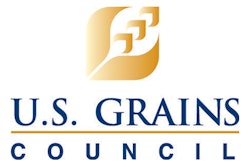
Located in the heartland of America, one 15-mile section of the Mississippi River in the St. Louis, Missouri, region delivers the highest level of grain barge handling capacity anywhere along the Mighty Mississippi. In fact, it is now being called the “Agriculture or Ag Coast” of America in terms of barge transfer facilities for agricultural products. To sustain and grow this impressive market share, infrastructure investment in multimodal interconnectivity is critical. And as production and demand for commodities like corn and soybeans continue to increase, the St. Louis region is strategically positioned to handle a significant portion of the expected increase in freight volume along this primary inland waterway. Those findings were revealed during a recent panel discussion at America’s Central Port in Granite City, Illinois, with David Jump, president of Cahokia, Illinois-based American Milling and Jeff Keirn from the Illinois Department of Transportation (IDOT). The meeting hosted by Bi-State Development, St. Louis Regional Freightway and America’s Central Port provided a positive outlook on the bi-state region’s role as a national and global freight hub.
Jump has more than 30 years of experience in the handling and transfer of grain along the Illinois and Mississippi Rivers. During the St. Louis Regional Freightway port working meeting, he said the amount of river business in the St. Louis region has disproportionately increased over the past three decades. He said not just because demand for the transfer of grain across the industry has increased but also because the bi-state region’s barge transfer facilities are earning recognition as a more cost-effective and efficient means to transfer products by barge for shipment to the Port of New Orleans as compared to other areas north of St. Louis. That recognition comes on the heels of investment of more than $200 million in the region’s agricultural product barge transfer infrastructure facilities since 2005.
“The St. Louis region is a rail and interstate highway gateway,” said Jump. “It is more cost-effective to move commodities into, out of and through St. Louis by combinations of truck, rail and barge than points upstream on the Mississippi and Illinois Rivers. The freight cost to ship large cargoes through places like Davenport (Iowa) or Peoria (Illinois) to and from New Orleans has increased significantly, while the freight cost to ship through St. Louis to New Orleans has not increased at all, and is in fact, netted down for this year.”
The reason it is more cost-effective for companies to transfer freight through the St. Louis region is due to the more efficient infrastructure and handling capacity offered via the region’s open waterways and barge transfer facilities. According to Jump, there has been consolidation in the river transportation industry over the last decade, and barge lines are becoming more streamlined by focusing on efficiency. Railroads have offered cheaper rates to large barge-loading facilities that can turn unit trains -- carrying 110 to 125 railcars of grain and agricultural product -- in just a few hours.
“Barge loading and unloading capacity has expanded in the St. Louis area to take advantage of these train rates and barge freight rate adjustments,” Jump said. “The four highest capacity grain barge loading facilities in the entire inland waterway are in Cahokia, Illinois. Three of the four were built in the past five years. As a result of increased handling capacity and favorable barge freight values, the St. Louis region has become a very significant destination for these trains.”
The four agricultural product transfer facilities in Cahokia are operated by Consolidated Grain and Barge Company (CGB); Louis Dreyfus; and China National Cereals, Oils and Foodstuffs Corporation (COFCO International) -- China’s state-owned grain and food processing manufacturer and trader. Jump noted that China has become a large buyer of soybeans with 35 percent of soybeans grown in the United States being exported to China. COFCO never owned a grain/agriculture barge transfer facility in the interior of the United States until last year when it invested in the St. Louis region. Jump said China will begin buying grain coming into Cahokia this fall.
单元列车沿线伊利诺斯州的频率3 has increased since 2016 and is expected to increase again this fall. In 2016, fluctuations resulted in as many as two unit trains crossing Route 3 a day, with each unit crossing Route 3 twice a day. In early 2017, the fluctuation reached four unit trains per day. In the fall, CGB will complete unit train rail improvements, which will increase the amount of unit trains that cross Illinois Route 3 to potentially six. According to Jump, COFCO has the capability for two additional unit trains with the potential to accommodate a four-unit train per day capacity. In addition, Jump said American Milling is planning for an additional barge transfer facility, which would increase the St. Louis region’s capacity to handle even more grain and grain products in the future.
The growth in capacity comes as the demand for exports continue to increase. Jump told the Freightway port working group members that U.S. soybean exports have increased from 20 million tons to 57 million tons over the past 30 years, and corn exports increased from 32 million tons to 57 million tons. The St. Louis region is seeing a direct economic impact as a result of this increase and its capacity to handle additional amounts of grain and agricultural products.
“In 1985, more than 5 percent of grain barges arriving in the New Orleans Harbors were coming from the St. Louis region, and now, that number has increased to about 30 percent,” said Jump. “The factors that are forcing growth in the St. Louis region are not going away. There is nothing on the river like the St. Louis region.”
Those factors credited with producing barge traffic growth include:
- 终端和高农用地产能过剩在河trations of barges, resulting in the St. Louis region having inexpensive barge freight rates for the handling of fertilizer, steel, manufactured goods, coal, petroleum products and agricultural commodities
- Intermodal connectivity – The region’s freight rail network includes six of the nation’s seven Class I railroad carriers and many of the region’s river terminals and public ports have the critical unit train capacity. Freight rail also has easy access to four interstate highways that include I-44, I-55, I-64 and I-70 which all provide national access.
- Geographic advantage – Centered in America’s agricultural heartland, the region provides the northernmost ice-free and lock-free access on the Mississippi River to and from the Gulf of Mexico.
Jump said while cargo handling capacity in the St. Louis region is booming, rail switching capacity is stretched. Demands on barge switching are at or over capacity, and the American farmer is currently growing near-record crops again for corn and for soybeans.
In order to keep up with demand, Mary Lamie, Executive Director of the St. Louis Regional Freightway, said it is vital for the bi-state region to continue to invest in roadway infrastructure as additional rail and truck traffic begin to cross the region. Region 5 IDOT Engineer Jeff Keirn updated the Freightway port working group members on the freight projects IDOT has identified as key regional priorities. Those include improvements to Illinois Route 3, a new bridge to carry traffic across the Mississippi River along I-270 north of St. Louis between Missouri and Illinois, a new interchange at I-255 in Dupo, Illinois and improvements to I-64, from Greenmount Road to Illinois Route 158 in St. Clair County. These priority projects, along with the proposed replacement of the Merchants Bridge, are among the 20 infrastructure projects the St. Louis Regional Freightway has identified as freight priorities.
“Infrastructure investment in our multimodal freight network is critical to ensure the United States remains competitive with the global market,” said Lamie.
To learn more about the St. Louis Regional Freightway, visit freightway.com.




















